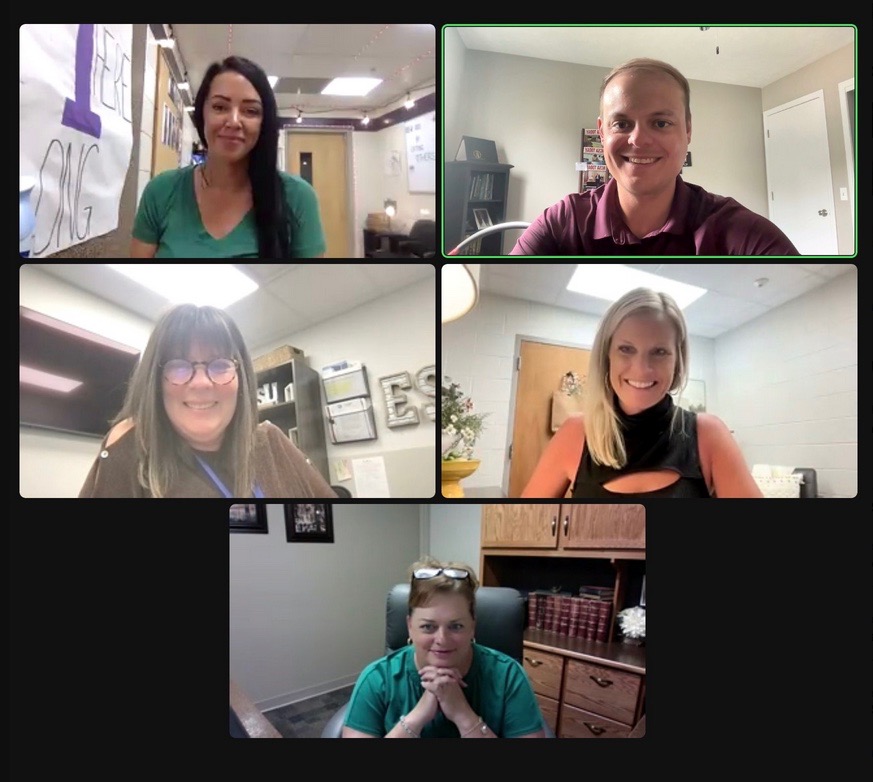After touring ESU 5 schools, ESU 16 puts its own spin on innovative mental health program out west
After touring ESU 5 schools, ESU 16 puts its own spin on innovative mental health program out west
By Tyler Dahlgren
Internal conversations at ESU 16 in Ogallala around mental health had been going on for two years when members of the service unit’s administrative team stepped in front of the mirror and came to an honest conclusion.
“The model we had in place was pretty clinical, and our discussions gave us this sense that we weren’t reaching all of the students we serve,” said ESU 16 Administrator Deb Paulman. “So we started thinking about expanding those services and supports to not just our kids, but our educators, too.”
The team unanimously decided to reinvent its model for mental health and wellness, a large undertaking that the staff was both on board with and excited about. But first, they needed a springboard. A model that could serve as their jumping off point.
Paulman looked east. Three-hundred miles east of Ogallala and the shores of Lake McConaughy, to Beatrice, where ESU 5’s model has been making waves for five years now.. Nebraska’s 17 service unit’s are spaced across the state, and yet, they’re connected. She picked up the phone, and made the call.
“It’s hard not to know about Jen McNally and the ESU 5 mental health work because it’s so unique and so dynamic,” Paulman said. “Jen’s been a trailblazer in this work that we’re all doing sort of as we’re in the midst of it.”
At one of the monthly ESU administrator meetings in Scottsbluff earlier this year, Paulman approached ESU 5 Administrator Brenda McNiff, and rather bluntly asked if she’d be open to a chat about mental health. “Of course,” McNiff responded, setting the ball in motion.
Paulman returned to Ogallala and floated the idea to her staff.
“Hey, would you all like to just go take a look at what a different, more inclusive and expansive model of providing mental health in schools might look like?” she asked.
Again, the response was a unanimous and resounding “Yes!” The two service units coordinated a Zoom call first, giving McNally an opportunity to introduce herself, her team, and their Wellness 4 All model. The short meet and greet proved to be powerfully productive.
“She rocked their world with some of her reflections and her perspectives on what that work should look like out in schools,” said Paulman. “Every word that came out of Jen’s mouth, they were writing down.”
McNally has been the Director of Mental Health and Wellness at ESU 5 for nearly six years. Coincidentally, she was hired after McNiff had had feelings similar to Paulman’s. They needed to shake things up. They needed to serve more students, McNiff was adamant about that.
“Not just the students that you could point out in a heartbeat in a school that definitely need mental health counseling,” explained McNiff, who entrusted McNally to paint on a blank canvas. “A number of the students Jen and her team serve are those high-flyers, those 4.0 students who are in a thousand activities and seem to have it all together.”
It’s been a labor of love for McNally, whose team was just equally excited to host the ESU 16 staff. Near the end of the semester, ESU 16 ventured from the land of Big Mac and sandhills to the home of the Homestead Monument. They made stops at Freeman Public Schools, Tri County Public Schools and Fairbury Public Schools.
The Wellness 4 All model has four foundational components: educator wellness, student wellbeing, professional development and building climate and culture. But it’s far from a cookie-cutter program, said McNally, who hoped that the ESU 16 staff would garner ideas of how they might be able to personalize the program after watching psychotherapists Cole Stark, Jamie Mapp and mental health clinician Sean Roberts in action.
“They’re the ones that had staff volunteer to talk about the program and had students show up and talk about what the services have meant for them,” McNally said of her team. “I hoped that they would gain insight into what they could do to incorporate their own program into what we’re doing, to make it their own. Every district is so different from one another.”
ESU 16 Teaching and Learning Director Allison Smith went into the tours focused on building capacity for students requiring tier-one support as well as expanding support for classroom teachers. She left with a better understanding of both, and couldn’t wait to get back to Central Nebraska to start building something similar and, at the same time, uniquely its own.
“Jen’s staff had this deep-seated grounding in the foundations that she’s created, and we saw that consistently throughout all three districts we visited,” Smith said. “It was super authentic. They were super authentic. The work is who they are and what they believe in, and I walked away saying, ‘Wow, they truly want the best for all kids.’”
Paulman said “A-Ha!” moments came in bunches for her mental health team throughout the day. Every conversation, every interaction, was strategic. That was impressive.
“To watch the ESU 5 staff integrate so seamlessly and naturally into the school environment was amazing,” Paulman said. “They were one hundred-percent known by kids, known by teachers and known by administrators. Everyone was in sync. It was such a beautiful, functional back-and-forth, give-and-take partnership between ESU 5 staff and district staff.”
Though the tours took place at the tail-end of the school year, you would have never known it. Morale in all three districts was high. So, too, was the energy, which Paulman called “palpable.” That was eye-opening, and indicative of the sturdiness of the model’s fourth pillar centered around school climate and culture.
Nebraska’s ESUs are no strangers to collaboration. Partnerships like these, distance be darned, come naturally. McNally knew Paulman and Smith from various conferences and meetings over the years. She knew the compass in their pockets was similar to the one in hers. Much like the Wellness 4 All model, the partnership was seamless.
“ESU 16 in particular is in line with our core values,” said McNally. “The passion and commitment to innovation in education and what that looks like. The day was great, and I have no doubt that ESU 16 will take their program into next year and continue to be as successful as they already have been.”
After wrapping up the day, ESU 16 hopped on I-80 and headed west, where the development and implementation processes awaited. They began to build their own pillars, 100-percent inspired by what they’d seen. New teaching and learning consultant Loree Cane, Paulman said, has been a driving force behind that.
“We did take our version of this work out to the schools that contract with us for mental health, and they are so jazzed about what’s coming next year,” Paulman said. “They are so excited about this shift and expansion in the way we provide support to our districts.”
Funny enough, the statewide collaboration led to internal collaboration. The more of that, the better.
“Not only did we collaborate across the state, but it pushed us to naturally collaborate across our ESU 16 departments, which I feel is critical to the success of this,” said Smith.
There’s hundreds of miles between Ogallala and Beatrice, but kids are kids, anywhere you go. The challenges they face are similar, and yet entirely their own.
So, too, are their triumphs. And in this model, there's plenty of those. The data says as much.
“Across the board, whether you’re an ESU in Nebraska or somewhere else, healthy kids are healthy learners,” said McNally. “And we know that students do better when they have those fundamental needs met.”



